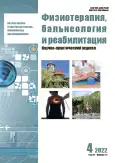The use of electrotherapy in complex treatment programs for patients after total arthroplasty
- Authors: Kolbakhova S.N.1, Kulchitskaya D.B.2, Khaptagaev T.B.3, Strukov R.N.4, Koneva E.S.3,4
-
Affiliations:
- State Research Center ― Burnasyan Federal Medical Biophysical Center of Federal Medical Biological Agency
- National Medical Research Center for Rehabilitation and Balneology
- MEDSI Group of Companies
- The First Sechenov Moscow State Medical University (Sechenov University)
- Issue: Vol 21, No 4 (2022)
- Pages: 281-287
- Section: Original studies
- URL: https://journals.rcsi.science/1681-3456/article/view/131076
- DOI: https://doi.org/10.17816/rjpbr115041
- ID: 131076
Cite item
Abstract
BACKGROUND: Total knee arthroplasty is one of the most common surgical interventions in the world and the Russian Federation. Endoprosthetics of the knee joint occupies a leading place in the structure of surgical methods for the treatment osteoarthritis.
AIM: of the study was to scientifically substantiate the feasibility of the complex use of electrical stimulation and therapeutic exercises in patients after total knee arthroplasty.
MATERIALS AND METHODS: We examined 60 patients who were admitted 3 months after TCS and were randomized into 2 groups. In the first group, 30 subjects received electrical stimulation of the quadriceps muscles and underwent therapeutic exercises, for a course of 10 procedures. The subjects of the second group, 30 people, had only physiotherapy exercises.
RESULTS: The use of electrotherapy and physiotherapy exercises, in the complex treatment of patients after total knee arthroplasty, improves the function of joint mobility. This is confirmed by the improvement in the functional activity of the operated joint according to the KSS scale (Кnee Society Scores), the improvement in the state of microcirculation and the positive dynamics of the pain syndrome according to the VAS (Visual Analog Scale). The obtained data of the HAQ (Health Assessment Questionnaire) questionnaire testify to the expansion of the possibilities for performing most of the activities in everyday life. However, more statistically significant results were obtained in patients after a course of quadriceps electrical stimulation and therapeutic exercises compared with the use of therapeutic exercises alone.
CONCLUSION: The complex of rehabilitation of patients after total knee arthroplasty presented by us, including electrostimulation and therapeutic gymnastics, is scientifically sound, effective and can be implemented into the basic scheme of outpatient and sanatorium treatment of this category of patients.
Full Text
##article.viewOnOriginalSite##About the authors
Svetlana N. Kolbakhova
State Research Center ― Burnasyan Federal Medical Biophysical Center of Federal Medical Biological Agency
Author for correspondence.
Email: svetlana.leo2011@yandex.ru
ORCID iD: 0000-0003-0191-5272
SPIN-code: 9572-3271
MD, Cand. Sci. (Med.), Assistant Professor
Russian Federation, MoscowDetelina B. Kulchitskaya
National Medical Research Center for Rehabilitation and Balneology
Email: deti_ku@mail.ru
ORCID iD: 0000-0002-7785-9767
SPIN-code: 2674-6371
MD, Dr. Sci. (Med.), Professor
Russian Federation, MoscowTimur B. Khaptagaev
MEDSI Group of Companies
Email: koneva.es@medsigroup.ru
ORCID iD: 0000-0003-2879-7114
Russian Federation, Moscow Region
Roman N. Strukov
The First Sechenov Moscow State Medical University (Sechenov University)
Email: doc.strukov@mail.ru
ORCID iD: 0000-0001-8797-7604
Graduate Student
Russian Federation, MoscowElizaveta S. Koneva
MEDSI Group of Companies; The First Sechenov Moscow State Medical University (Sechenov University)
Email: elizaveta.coneva@yandex.ru
ORCID iD: 0000-0002-9859-194X
SPIN-code: 8200-2155
MD, Dr. Sci. (Med.), Professor
Russian Federation, Moscow Region; MoscowReferences
- Chughtai M, Elmallah RD, Mistry JB, et al. Nonpharmacologic pain management and muscle strengthening following total knee arthroplasty. J Knee Surg. 2016;29(3):194–200. doi: 10.1055/s-0035-1569147
- Eskin NA, Andreeva TM. The state of specialized traumatological orthopedic care in the Russian Federation. Bulletin Traumatology Orthopedics named after N.N. Priorov. 2017;(1):5–11. (In Russ).
- Bozic KJ, Kamath AF, Ong K, et al. comparative epidemiology of revision arthroplasty: failed THA poses greater clinical and economic burdens than failed TKA. Clin Orthop Relat Res. 2015;473(6):2131–2138. doi: 10.1007/s11999-014-4078-8
- Wang X, Hunter DJ, Vesentini G, et al Technology-assisted rehabilitation following total knee or hip replacement for people with osteoarthritis: A systematic review and meta-analysis. BMC Musculoskeletal Disorders. 2019;1(20):506. doi: 10.1186/s12891-019-2900-x
- Kulchitskaya DB, Konchugova TV, Solomatina MO. Non-drug methods of treatment of patients with gonarthrosis. Bulletin Restorative Med. 2019;(2):40–43. (In Russ).
- Kulchitskaya DB, Konchugova TV, Minenkov AA, Kolbaya LI. Technologies of restorative medicine in the correction of microcirculatory disorders in patients with gonarthrosis. Questions Balneology Physiotherapy Therapeutic Physical Culture. 2012;89(1):14–16. (In Russ).
- Alqualo-Costa R, Thomé GR, Perracini MR, Liebano RE. Low-level laser therapy and interferential current in patients with knee osteoarthritis: a randomized controlled trial protocol. Pain Management. 2018;8(3):157–166. doi: 10.2217/pmt-2017-0057
- Mistry JB, Elmallah RD, Bhave A, et al. Rehabilitative guidelines after total knee arthroplasty: A review. J Knee Sur. 2016;29(3):201–217. doi: 10.1055/s-0036-1579670
- Zhang Q, Zhang JH, Tong P. [Application of transcutaneous electrical nerve stimulation to multimodal analgesia after total knee arthroplasty]. Zhongguo Gu Shang. 2014;27(4):283–286. (In Chinese).
- Şavkin R, Büker N, Güngör HR The effects of preoperative neuromuscular electrical stimulation on the postoperative quadriceps muscle strength and functional status in patients with fast-track total knee arthroplasty. Acta Orthopaedica Belgica. 2021;87(4):735–744. doi: 10.52628/87.4.19
- Bistolfi A, Zanovello J, Ferracini R, et al. Evaluation of the effectiveness of neuromuscular electrical stimulation after total knee arthroplasty: A meta-analysis. Am J Physical Med Rehabilitation. 2018;97(2):123–130. doi: 10.1097/PHM.0000000000
- Fatoye F, Wright JM, Yeowell G, Gebrye T. Clinical and cost-effectiveness of physiotherapy interventions following total hip replacement: A systematic review and meta-analysis. Rheumatology Int. 2020;40(9):1385–1398. doi: 10.1007/s00296-020-04597-2
Supplementary files






